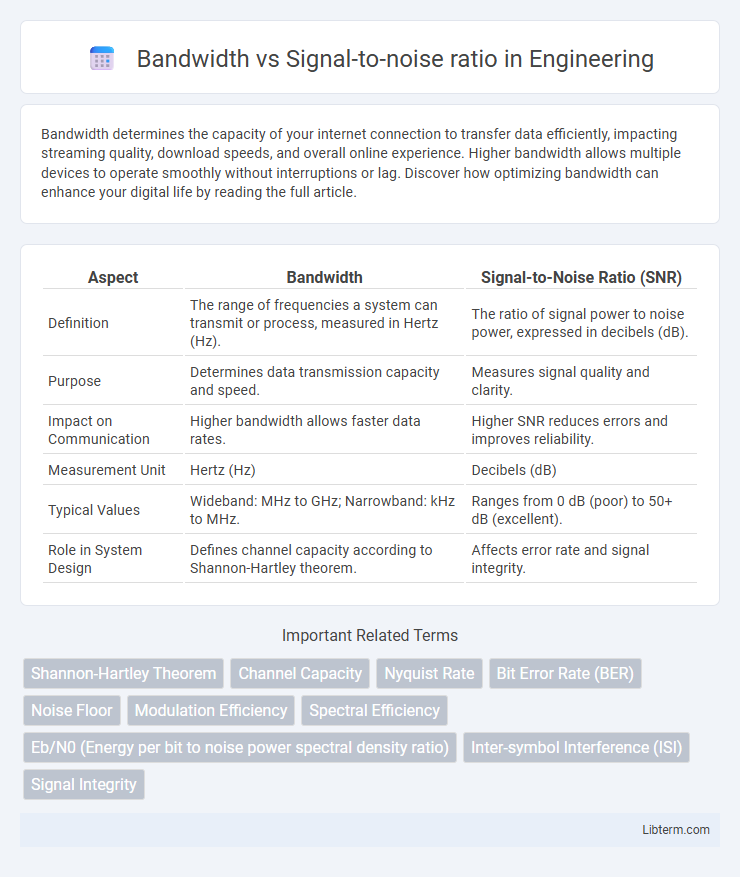Bandwidth determines the capacity of your internet connection to transfer data efficiently, impacting streaming quality, download speeds, and overall online experience. Higher bandwidth allows multiple devices to operate smoothly without interruptions or lag. Discover how optimizing bandwidth can enhance your digital life by reading the full article.
Table of Comparison
| Aspect | Bandwidth | Signal-to-Noise Ratio (SNR) |
|---|---|---|
| Definition | The range of frequencies a system can transmit or process, measured in Hertz (Hz). | The ratio of signal power to noise power, expressed in decibels (dB). |
| Purpose | Determines data transmission capacity and speed. | Measures signal quality and clarity. |
| Impact on Communication | Higher bandwidth allows faster data rates. | Higher SNR reduces errors and improves reliability. |
| Measurement Unit | Hertz (Hz) | Decibels (dB) |
| Typical Values | Wideband: MHz to GHz; Narrowband: kHz to MHz. | Ranges from 0 dB (poor) to 50+ dB (excellent). |
| Role in System Design | Defines channel capacity according to Shannon-Hartley theorem. | Affects error rate and signal integrity. |
Understanding Bandwidth: Definition and Importance
Bandwidth refers to the range of frequencies within a given band that a transmission channel can carry, directly impacting data transfer rates and communication quality. It is essential for determining the capacity of a network, as higher bandwidth allows for more data to be transmitted simultaneously, improving overall system performance. Understanding bandwidth is crucial for optimizing signal-to-noise ratio (SNR), as sufficient bandwidth ensures clearer signal transmission and reduces errors caused by noise interference.
What is Signal-to-Noise Ratio (SNR)?
Signal-to-Noise Ratio (SNR) measures the strength of a desired signal relative to background noise, expressed in decibels (dB). Higher SNR values indicate clearer communication channels with less distortion, essential for maintaining data integrity. SNR directly influences bandwidth efficiency, as better SNR allows for higher data rates within a given bandwidth.
The Relationship Between Bandwidth and SNR
The relationship between bandwidth and signal-to-noise ratio (SNR) is crucial in communication systems, as increasing bandwidth typically results in a higher noise floor, thereby reducing SNR. According to the Shannon-Hartley theorem, the channel capacity is directly proportional to bandwidth and logarithmically related to SNR, highlighting that wider bandwidths require stronger signals to maintain data integrity. Effective system design balances bandwidth expansion with SNR improvements to optimize data transmission rates and minimize errors.
How Bandwidth Affects Signal Quality
Bandwidth determines the range of frequencies that a communication channel can transmit, directly impacting data transfer rates and signal fidelity. Higher bandwidth enables the transmission of more information but can also introduce more noise, potentially lowering the signal-to-noise ratio (SNR). Optimal signal quality requires balancing bandwidth to maximize SNR, ensuring clear and reliable communication with minimal interference.
Impact of SNR on Communication Performance
Signal-to-noise ratio (SNR) significantly influences communication performance by determining the clarity and reliability of the transmitted signal within a given bandwidth. Higher SNR values enhance data transmission rates and reduce bit error rates, optimizing overall system efficiency. Low SNR leads to increased noise interference, resulting in degraded signal quality and limited bandwidth utilization.
Bandwidth vs SNR: Key Differences
Bandwidth measures the range of frequencies a communication channel can transmit, directly impacting data transfer rates and overall capacity. Signal-to-noise ratio (SNR) quantifies the strength of the desired signal relative to background noise, influencing the clarity and reliability of the received information. Higher bandwidth enables faster data transmission, while higher SNR improves signal quality; both parameters are critical but operate independently in optimizing communication system performance.
Real-World Applications: Bandwidth vs SNR
In real-world applications, bandwidth directly impacts data transmission rates while signal-to-noise ratio (SNR) determines signal clarity and quality. High bandwidth enables faster communication but requires maintaining a sufficient SNR to minimize errors and interference, especially in wireless and fiber-optic networks. Technologies like 4G LTE and Wi-Fi balance bandwidth and SNR to optimize performance and user experience in varying environmental conditions.
Optimizing Networks: Balancing Bandwidth and SNR
Optimizing networks requires balancing bandwidth and signal-to-noise ratio (SNR) to maximize data throughput and maintain signal integrity. Higher bandwidth enables faster data transmission but often reduces SNR due to increased noise levels, impacting error rates and overall network performance. Engineers must carefully design modulation schemes and deploy noise-reduction techniques to achieve an optimal trade-off that supports reliable communication with minimal latency.
Challenges in Managing Bandwidth and Signal-to-Noise Ratio
Managing bandwidth and signal-to-noise ratio (SNR) presents significant challenges due to their interdependent effects on overall communication quality. Increasing bandwidth often introduces more noise, reducing SNR and degrading signal clarity, while improving SNR typically limits bandwidth availability, constraining data throughput. Balancing these parameters requires advanced modulation techniques and adaptive filtering to optimize performance in varying transmission environments.
Future Trends in Bandwidth and SNR Technologies
Future trends in bandwidth and signal-to-noise ratio (SNR) technologies emphasize advancements in adaptive modulation and coding techniques to maximize spectral efficiency. Emerging 6G networks aim to exploit terahertz frequencies, significantly increasing available bandwidth while deploying sophisticated noise reduction algorithms and AI-driven signal processing to enhance SNR. These innovations promise ultra-high data rates and improved communication reliability essential for applications like augmented reality and autonomous systems.
Bandwidth Infographic

 libterm.com
libterm.com